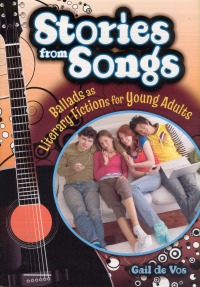| ________________
CM . . .
. Volume XVI Number 23. . . .February 19, 2010 
 |
Stories from Songs: Ballads as Literary Fictions for Young Adults
Gail de Vos.
Westport, CT: Libraries Unlimited (Distributed in Canada by the OLA Store), 2009.
453 pp., pbk., $48.00 (US).
ISBN 978-1-59158-424-7.
Subject Headings:
Ballads, English-United States-History and criticism.
Ballads, English-Great Britain-History and criticism.
Ballads in literature.
Literature and folklore.
Young adult fiction-History and criticism.
Teenagers-Books and reading.
Professional: Grades 7-12.
Review by Kay Weisman.
**** /4
|
| |
|

excerpt:
Traditional ballads, songs that tell a story that has been distilled to its essence and set to music, have been passed down through the centuries, changing to suit the tastes of singers, borrowing from the music of the day, and borrowing from each other. There is "stress on situation, rather than on continuity of narrative or on character as character is presented in heroic poems or prose stanzas."
Ballads generally have been categorized into seven distinct groupings: minstrel ballads; broadside ballads; the infamous Child ballads of the Old World; the "native" ballads of the New World; the blues ballad, which also originated in North America; the sentimental ballad, which reached its peak at the turn of the twentieth century; and the literary ballad.
In a companion volume to New Tales for Old: Folktales as Literary Fictions for Young Adults (Gail de Vos and Anna Altmann, Libraries Unlimited, 1999) and Tales, Then and Now: More Folktales as Literary Fictions for Young Adults (Anna Altmann and Gail de Vos, Libraries Unlimited, 2001) De Vos, an adjunct professor at the School of Library and Information Studies, University of Alberta, Edmonton, tackles another traditional literary form—the ballad. She begins with a general discussion of these musical stories, offering a definition, common elements, detailed descriptions of seven distinct types, and a rationale for exploring modern variations of these songs. Subsequent chapters are arranged thematically: historical ballads, riddle ballads, murder ballads, tragic love stories, materializing renevants, otherworldly beings, shape shifters and female monsters, tricks and disguises, national ballads, and a sampling of others.
De Vos's writing is thorough and scholarly, yet accessible. Each thematic chapter covers several relevant ballads; she provides plot summaries, alternate titles, performance histories, critiques of critical research, and discussions of contemporary literary versions, including novels, short stories, graphic novels, poetry, and internet resources. She also includes numerous tables that organize related details such as the developmental stages of a particular ballad or the variants of a song.
For example, author's section on "The Gypsy Laddie," from the chapter on tragic love stories, notes that this is a Child ballad, type 200, about a lady who, enchanted by the gypsies, follows their leader, Johnny Faa. Her husband rides to fetch her, killing 15 gypsies in the process. De Vos describes several common variations, noting artists such as Bob Dylan and Woody Guthrie and the versions they have sung. She cites more than fifty alternate titles for this song, including "How Old Are You My Pretty Little Miss?" and "Black Jack Davey," and summarizes the history of this ballad in a chart with entries dating back to Plato in the fourth century. In addition, she cites and describes more than thirty critical interpretations of this song, published between 1932 and 2004. She notes three related novels (including Philip Pullman's The Golden Compass), three short stories, three poems, one picture book, and three relevant web sites. Each literary adaptation is fully described and critiqued.
De Vos does not discuss melodies, preferring to concentrate instead on the stories. Her work is heavily footnoted, and her numerous references will serve as a useful resource for other researchers. Multiple indexes (author/illustrator/musician, ballad, and title) assure that readers will find what they are looking for, making this a good choice for high school or university fine arts collections.
Highly Recommended.
Kay Weisman is a Master of Arts in Children's Literature candidate at the University of British Columbia.

To comment
on this title or this review, send mail to cm@umanitoba.ca.
Copyright © the Manitoba Library Association. Reproduction for personal
use is permitted only if this copyright notice is maintained. Any
other reproduction is prohibited without permission.
NEXT REVIEW |
TABLE OF CONTENTS FOR THIS ISSUE
- February 19, 2010.
AUTHORS |
TITLES |
MEDIA REVIEWS |
PROFILES |
BACK ISSUES |
SEARCH |
CMARCHIVE |
HOME |
